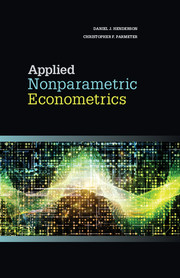Book contents
- Frontmatter
- Dedication
- Contents
- 1 Introduction
- 2 Univariate density estimation
- 3 Multivariate density estimation
- 4 Inference about the density
- 5 Regression
- 6 Testing in regression
- 7 Smoothing discrete variables
- 8 Regression with discrete covariates
- 9 Semiparametric methods
- 10 Instrumental variables
- 11 Panel data
- 12 Constrained estimation and inference
- Bibliography
- Index
12 - Constrained estimation and inference
Published online by Cambridge University Press: 05 February 2015
- Frontmatter
- Dedication
- Contents
- 1 Introduction
- 2 Univariate density estimation
- 3 Multivariate density estimation
- 4 Inference about the density
- 5 Regression
- 6 Testing in regression
- 7 Smoothing discrete variables
- 8 Regression with discrete covariates
- 9 Semiparametric methods
- 10 Instrumental variables
- 11 Panel data
- 12 Constrained estimation and inference
- Bibliography
- Index
Summary
While the nonparametric regression methods we have discussed are flexible, a side effect of this flexibility is that the estimated function may not satisfy certain prior information (exact or assumed), such as monotonicity or positivity. A generic example of this is estimating a conditional mean model where the left-hand-side variable lies between zero and one. It is well known that a local-linear estimator is not guaranteed to produce a smooth function that always lies between these bounds. Thus, it is useful to discuss a set of tools that can be used to ensure that nonparametric estimates satisfy specific smoothness constraints.
An additional benefit of imposing constraints in a nonparametric framework is that it may provide nonparametric identification (see Matzkin, 1994). Also, Mammen, Marron, Turlach, and Wand (2001) show that when we impose constraints on derivatives higher than the first order, the rate of convergence is faster than it would be had the constraints not been imposed.
A rich and diverse literature on constrained estimation has emerged and a multitude of potential estimators have been proposed for various constrained problems. We do not attempt to survey all existing constrained estimation methods. Rather, we refer the interested reader to Henderson and Parmeter (2009) for a detailed survey. Instead, we focus our discussion on three flexible and widely used methods: rearrangement, data sharpening, and constraint-weighted bootstrapping. Each of these methods has its costs and benefits, but all three are sufficiently flexible to warrant further investigation.
Perhaps the most general of the methods, constraint-weighted bootstrapping can be used to impose a wide range of smoothness constraints, from positivity and monotonicity, to constant returns to scale and additive separability. Further, this method is sufficiently flexible that it can be implemented with any of the local-polynomial estimators described in Chapter 5. We detail the implementation of this estimator and conduct inference for general hypotheses regarding the smoothness of the unknown conditional mean.
- Type
- Chapter
- Information
- Applied Nonparametric Econometrics , pp. 321 - 342Publisher: Cambridge University PressPrint publication year: 2015



